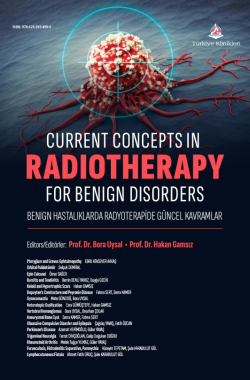Lymphocutaneous Fistula
Ahmet Fatih ORUÇa , Şule KARABULUT GÜLb
aPendik Medical Park Hospital, Clinic of Radiation Oncology, İstanbul, Türkiye
bUniversity of Health Sciences Faculty of Medicine, Kartal Dr. Lütfi Kırdar City Hospital, Department of Radiation Oncology, İstanbul, Türkiye
Oruç AF, Karabulut Gül Ş. Lymphocutaneous fistula. In: Uysal B, Gamsız H, eds. Current Concepts in Radiotherapy for Benign Disorders. 1st ed. Ankara: Türkiye Klinikleri; 2025. p.72-4
ABSTRACT
Lymphocutaneous fistulas are complications typically arising after surgical procedures, characterized by the leakage of lymphatic fluid through the skin. This study reviews the definition, causes, and treatment approaches for lymphocutaneous fistulas. Particularly following vascular surgeries, these fistulas often close spontaneously but may require additional treatments in some cases. Treatment options include conservative methods, sclerosing agent injections, and radiotherapy. Radiotherapy, when applied in low doses, has proven to be an effective method for reducing lymphatic drainage. Various studies have reported high success rates and good tolerability of radiotherapy in treating lymphocutaneous fistulas. However, there is no established protocol for optimal dose, fractionation, and treatment duration. Radiotherapy is considered a reliable and effective alternative when conservative treatments fail or are prolonged.
Keywords: Fistula; radiotherapy; conservative treatment
Kaynak Göster
Referanslar
- Giovannacci L, Eugster T, Stierli P, Hess P, Gurke L. Does fibrin glue reduce complications after femoral artery surgery? A randomised trial. Eur J Vasc Endovasc Surg. 2002;24:196-201. [Crossref] [PubMed]
- Dietl B, Pfister K, Aufschlager C, et al. Radiotherapy of inguinal lymphorrhea after vascular surgery. A retrospective analysis. Strahlenther Onkol. 2005;181:369-400. [Crossref] [PubMed]
- Töpel I, Wiesner M, Uhl C, et al. Retrograde thromboendarterectomy vs. iliofemoral bypass in unilateral iliac TASC C and D lesions. Vasa. 2015;44:211-9. [Crossref] [PubMed]
- Kent KC, Bartek S, Kuntz KM, et al. Prospective study of wound complications in continuous infrainguinal incisions after lower limb arterial reconstruction: incidence, risk factors, and cost. Surgery. 1996;119:378-83. [Crossref] [PubMed]
- Tyndall SH, Shepard AD, Wilczewski JM, et al. Groin lymphatic complications after arterial reconstruction. J Vasc Surg. 1994;19:858-64. [Crossref] [PubMed]
- Van den Brande P, von Kemp K, Aerden D, Debing E, Vanhulle A, Staelens I, et al. Treatment of lymphocutaneous fistulas after vascular procedures of the lower limb: Accurate wound reclosure and 3 weeks of consistent and continuing drainage. Ann Vasc Surg. 2012;26:833-8. [Crossref] [PubMed]
- Croft RJ. Lymphatic fistula: a complication of arterial surgery. Br Med J. 1978;2:205. [Crossref] [PubMed] [PMC]
- Kutzner J, Roesler A. Diagnostics and therapy of lymphocysts. Tumor Diagnostik Therapie. 1986;7:108-12.
- Neu B, Gauss G, Haase W, et al. Radiotherapy of lymphatic fistula and lymphocele. Strahlenther Onkol. 2000;176:9-15. [Crossref] [PubMed]
- Hautmann MG, Dietl B, Wagner L, Zeman F, Kölbl O, Pfister K, et al. Radiation therapy of lymphatic fistulae after vascular surgery in the groin. Int J Radiat Oncol Biol Phys. 2021;111(4):949-958. [Crossref] [PubMed]
- Mayer R, Sminia P, McBride WH, et al. Lymphatic fistulas: Obliteration by low-dose radiotherapy. Strahlenther Onkol. 2005;181:660-4. [Crossref] [PubMed]
- Pérez J, Arribas JM, Cárdenas E, Gutiérrez F, Taboada R, Cassinello N. Radiotherapeutic management of the chyloperitoneum following abdominal aortic aneurysm repair. J Vasc Surg. 2013;1:409-11. [Crossref] [PubMed]
- Jazmati D, Tamaskovics B, Hoff NP, Homey B, Bölke E, Boyomo B, et al. Percutaneous fractionated radiotherapy of the groin to eliminate lymphatic fistulas after vascular surgery. Eur J Med Res. 2023;28(1):70. [Crossref] [PubMed] [PMC]

